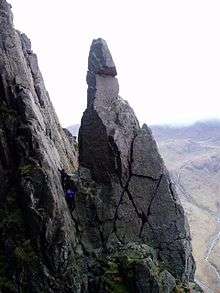Walter Parry Haskett Smith
Walter Parry Haskett Smith (28 August 1859 – 11 March 1946) is often called the Father of Rock Climbing. Born in Bognor Regis, England, the son of a wealthy landowner, he attended Eton where he excelled at athletics, before enrolling in Trinity College, Oxford. He was the younger brother of the cricketer Algernon Haskett-Smith.
Walter Parry Haskett Smith | |
|---|---|
| Born | 28 August 1859 |
| Died | 11 March 1946 (aged 86) |
Background

At Oxford he studied law and continued along a promising athletic path, reaching a long jump (unofficial) world record of 25 feet once in practice. On a university reading party at Aber, Wales in 1880, Haskett Smith became interested in exploring local cliffs, and in 1881 he journeyed to the Lake District and took a room at the inn at Wasdale Head, staying there for two months, meeting Frederick Herman Bowring, an enthusiastic fell-scrambler some forty years older, and, in essence, becoming Bowring's protégé. Bowring had also been an athlete in his university days, reaching 21 feet in the long jump in the 1840s.
By the following summer, Haskett Smith had begun to record his efforts – which were more akin to what we now think of as rock climbing than to the exposed scrambles of previous generations. His most famous climb was his 1886 first ascent of the Napes Needle, which he accomplished, by himself, without any sort of protective devices - eschewing the use of ropes, spikes, and ladders as aids required by inferior climbers. His climbing style was muscular and gymnastic, similar to that of Owen Glynne Jones, Haskett Smith's successor - after 1895 - as leading British rock climber.
A lifelong devotee of etymologies, and possessing a gift for describing past acquaintances, Haskett Smith delighted in producing rambling and witty pieces about his athletic avocation. For instance, in his description of Bear Rock in "Climbing in the British Isles", the reader divines a subtle poke at the new pastime of bouldering: "a queerly-shaped rock on Great Napes, which in the middle of March, 1889 was gravely attacked by a large party comprising some five or six of the strongest climbers in England. It is a little difficult to find, especially in seasons when the grass is at all long."[1]
Further reading
- Haskett Smith, W. P. (1894), "Climbing in the British Isles", Facsimile edition by The Ernest Press, 1986
- Perrin, Jim (1986), Playful Progenitor – Prelude to the facsimile edition of "Climbing in the British Isles"
See also
References
- Hankinson, Alan (1972), "The First Tigers", J. M. Dent & Sons